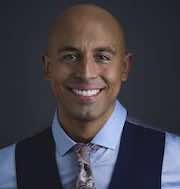
In the last four years, with attacks on transgender people rising and political sentiments reflecting opposition to transgender communities, the creative world has flexed its power to shape the national conversation, featuring a new class of stars and introducing us to new identities like that of Elliot Page.
In the U.S., More people have a television than a college degree, and while 69% of Americans voted in the 2020 election, over 50% use a streaming service and nearly 66% have cable. Our screens tell the story of who this country belongs to, and trans and gender-nonconforming filmmakers are forcing the industry to face the true power of on-screen representation and the lasting significance of transphobic imagery in the media.
Representation Means Humanization
High-profile artists like Laverne Cox are bringing to light the real-world cost of media invisibility: dehumanization. If the network shows, films, and streaming programs that audiences invite into their homes everyday feature human beings from different walks of life, viewers are more likely to engage with them humanely face-to-face.
Media outlets have a dramatic effect on the perception of crime within minority communities, and the national conversation has proven to have a symbiotic relationship with media consumed both for news and entertainment. Conversely, problematic depictions of transgender and gender-nonconforming characters contribute to what Jessica J. Nobe calls the “vicious cycle of misrepresentation of transgender characters:”
“The jokes and characters are written to appeal to the demographic, and when they are presented they reaffirm any existing stereotypes a less knowledgeable viewer might have. Certainly, it cannot be one individual’s misconception if the misconception has made it through writing, editing, production, and broadcast process. It makes the statement that there are like-minded people out there who agree that transgender characters (and therefore transgender people) are not the norm…”
For Ms. Cox, the systemic prejudices facing her gender identity and notoriety of her meteoric rise (epitomized in her appearance on the cover of Time) came into sharp relief: she began having fans rush her on the streets of New York City to show love and appreciation, a change from the public harassment often emboldened by transphobic messaging in the media (according to an interview on the LGBTQ&A Podcast).
Representation Is a Vehicle for Telling Cultural Stories
As rising stars in shows like DAVID MAKES MAN, SHAMELESS, BILLIONS, STAR, ORANGE IS THE NEW BLACK and THE OA has given platforms for trans and nonbinary actors to tell their stories, the industry would do well to remember that representation is a goal, and fetishization is a pitfall.
For too long, trans and gender-nonconforming roles have served as vehicles for high-profile CIS Gender actors in films and television shows ranging from TRANSPARENT and DALLAS BUYERS CLUB to films like FLAWLESS and BOYS DON’T CRY. Setting aside the caliber of the performances, the fact of those casting decisions remains problematic for one simple reason: representation on-screen serves only as corporate lip service if it does not act as a vehicle for the culture or people being represented. A transgender character should be played by a transgender person, and the profit from that work should go to them too—be it in the form of pay, critical response, or exposure.
By and large, this is a point on which audiences, artists, and activists agree. The public and critical response go hand-in-hand with accurate representation, and audiences have consistently clamored for new talent from diverse gender backgrounds. Conversely, public tastes have outpaced industry sensibilities, leading to well-deserved controversy when a Cis Gender Actress was cast to play a transgender man. While decisions such as these are often beyond the scope of the screenwriter, representation begins on the page: as a prominent example, reaching out to GLAAD is becoming an industry norm for writers. Staffing a room with trans and gender-nonconforming writers is also a gold standard for bringing gender-diverse stories to life.
Representation is a Commitment
Telling the stories of trans and gender-nonconforming characters highlights the most significant way in which these filmmakers are shaking up the long sedimentary Hollywood bedrock: the choice between accepted norms and artistic risk. Featuring high-profile CIS gender actors in Transgender leads is problematic on many tiers, but the justifications are most commonly economic.
A film is an art form broken down into projects, and those projects are built around the fiscal viability of stars across domestic and international marketability. While that system is trusted to generate profit in theory, it has in reality launched box office juggernauts and flops alike. The incoming class of filmmakers has to make a choice between the illusion of economic certainty, and the bold choice to tell stories that are groundbreaking and inclusive. That choice means betting against heteronormativity as a default leading role characteristic and supporting the discovery of new gender-nonconforming talent.
This journey starts on the page, with a critical mass of writers who opt to provide screenwriting to meet the societal demand of films that increasingly look like the diverse American landscape.
“The decision-makers are listening, and it can only do more good, especially in times like these where legislators are making laws that make it difficult for trans people to live their lives,” says Brian Michael Smith, a transgender actor and series regular on 9-1-1: LONESTAR. “They’re pushing for these laws because they don’t know any trans people. If they can see representations of trans people in the media, it’ll maybe help them understand the actions they are taking are harming actual people.”
350 transgender people were killed by hate crimes in 2020. When inclusion and representation are a matter of life and death, the only moral choice for artists is to rise to the occasion.
Not sure how to handle representation in your script? Check out the resources at GLAAD, activist Julia Serano’s guide to terminology, Transgender Studies Quarterly; as well as the award-winning work of Rhys Ernst (TRANSPARENT: THIS IS ME) who is helping to make WeScreenplay’s Diverse Voices Lab more inclusive for the transgender community.
 Joshua Noble is a Puerto Rican writer, actor, and producer based in Los Angeles, California. In addition to his career in TV and film, he is a founding producer of The American Playbook, a series of conversations and new works highlighting historically underrepresented voices, and currently serves as Director of the National Actors’ Retreat. Joshua received his MFA from the Yale School of Drama.
Joshua Noble is a Puerto Rican writer, actor, and producer based in Los Angeles, California. In addition to his career in TV and film, he is a founding producer of The American Playbook, a series of conversations and new works highlighting historically underrepresented voices, and currently serves as Director of the National Actors’ Retreat. Joshua received his MFA from the Yale School of Drama.
For all the latest from WeScreenplay, be sure to follow us on Twitter, Facebook, and Instagram.

















